The ethereal aesthetic of Caroline Bagenal’s Summer Palace—on view at Boston Sculptors Gallery through June 11—awakens one’s emotions. In this exhibition, her sculptures hang from the ceiling rather than stand on plinths. They activate the gallery’s negative space, immediately engaging the viewer. Likewise, Bagenal’s minimal materials and repeated motifs take on emotive strength through association between the mysterious and the known, the abstract and the familiar.
Suspended by the entrance of the front gallery and floating above the floor, Summer Palace is the central piece of the show. The exhibition also comprises a room of two-dimensional wall-mounted works in similar colors and materials as Summer Palace, as well as other hanging paper works. Summer Palace is composed of grid-like panels of paper-wrapped and painted willow branches and marsh reeds. This airy sculpture reaches toward architecture. Yet what kind of function the structure would serve remains unclear. Summer Palace certainly employs the monumentality, symmetry, and patterned intricacy of royal architecture. On the other hand, its open weave suggests the lath bones of a simple dwelling. Meanwhile, the dappled shadows cast by the weave evoke the shelter of a tree’s summertime canopy, reminding the viewer that Summer Palace’s materials were gathered from the natural world, and introducing a ghostly mood to the piece.
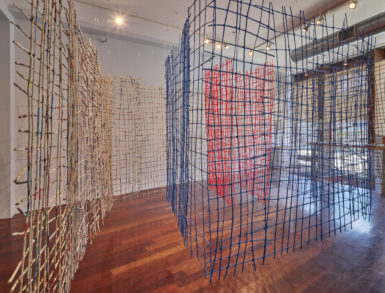
Caroline Bagenal, Summer Palace, 2017, willow branches, marsh reeds, newspapers, paint, dimensions variable. Photo Credit: Stewart Clements.
Gallery-goers are drawn inside the sculpture’s maze-like interior, where neutral beiges soon change to blue, before reaching a core of vivid neon orange. While the color transition is easily visible from the outside, the corridor formed by the willow panels narrows unexpectedly. Only one person can fit within the orange inner sanctum at a time. Summer Palace’s catch and release calls into question what we seek in our imaginary palaces, and whether inhabiting a space lets us take possession of it. Maybe Summer Palace has nothing to do with taking shelter. Does space, ultimately, posses us?
Interestingly, Bagenal provides not an artist’s statement, but a series of simple “notes” left unobtrusively on a corner of the gallery sitter’s desk. Many of her works engage with memories, or even use actual personal artifacts. This specificity in Bagenal’s inspiration and process is not evident until the viewer reads the notes. Summer Palace, for example, is “a real place on Alston Moor in Cumbria, [Northern] England where [she] used to hang out… It was a semi derelict structure with no heat and a flat roof.” It’s a testimony to the strength of Bagenal’s sculpture that these brief explanations do not lessen the mysterious physical presence of the work itself on the viewer.
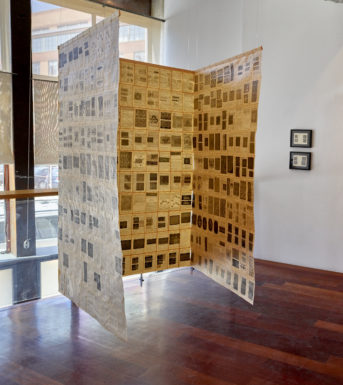
Caroline Bagenal, Book of Hours, 2017, paper, 52" x 32" x 32". Photo Credit: Stewart Clements.
A similar experience occurs before Book of Hours, a three-paneled, paper sculpture that echoes Summer Palace’s orange core (call and refrain is a running theme in the exhibition’s graphic vocabulary). This time, it is easy to see that the individual pages glued together to compose the panels like a quilt are from an old embroidery book, which Bagenal explains belonged to a great aunt. It would be easy enough to enjoy the elegance of this object’s material alone, but something in its semi-enclosed, semi-open stance (and quasi-religious title) demands reconsideration. The Book of Hours’ devotional tone is impossible to divorce from obsession. Once again, questions are raised: Is the artist, embroiderer, or craftsperson a master of her craft, or a slave to perfection? Indeed, is the one tantamount to the other?
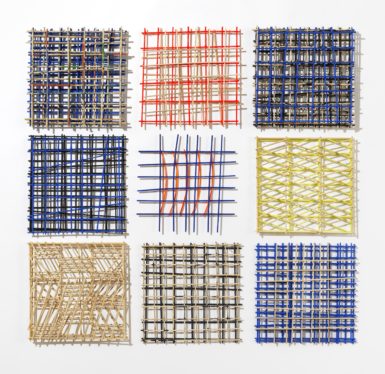
Caroline Bagenal, Themes and Variations, 2016, bamboo, paint, 30" x 30" x 3". Photo Credit: Stewart Clements.
On the walls surrounding Book of Hours and Summer Palace, Bagenal’s two-dimensional work is made up largely of her Themes and Variations series, grids of painted bamboo. Like the free-floating sculptures, Themes and Variations reference practices beyond pure abstraction: in this case, music and writing. While they are intriguing in their own right, at Boston Sculptors they provide the necessary backdrop for a work like Summer Palace—just enough color and shared materials to help integrate the latter work into the white walls and polished floors of the gallery.
Walking through the exhibition, one gets a sense of Bagenal’s passion for materials and abstraction. Yet the strength of Summer Palace surely lies in how these works build an emotionally charged atmosphere from such a carefully restricted palette of colors and forms. In Bagenal’s hands, a grid can be almost anything: a palace, a shed, a bar of music, or a hieroglyph. Her paper forms can look like altars, yet they are just as easily translated as quilts, newspapers or any number of familiar objects. It’s because the works are so open to interpretation that the space around them becomes so inhabitable for visitors, their memories and those of the artist.

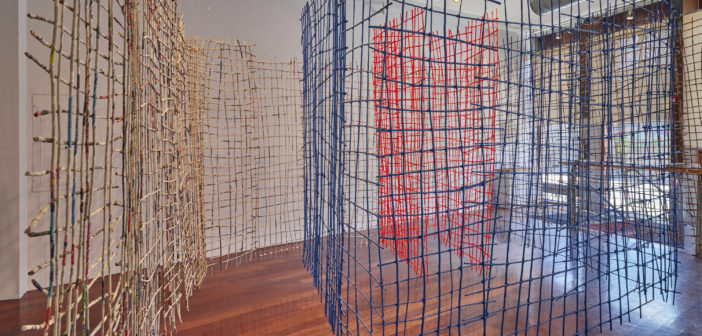
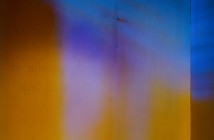
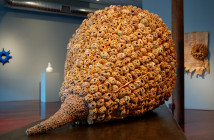
2 Comments
What a beautiful review, Olivia!.. I totally concur — and very much enjoyed your turn of phrase, such as: “call and refrain is a running theme in the exhibition’s graphic vocabulary”… . Kudos!
Thank you, Philip!